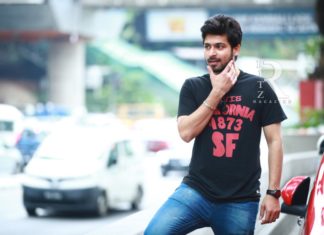Forget security guards and red tape. Forget letters, telephone calls and emails. Today if you want to reach Sushma Swaraj, all you have to do is send her a tweet. Like many a grateful citizen has found.
What is this animal called social media? Mankind has lived for centuries without encountering social media. But today it rules our world. Can we do without it? Can we harness its good and banish or restrict its bad? Will the government come down heavily on social media? Is it possible to do so?
[wzslider autoplay=”true” transition=”‘slide'” lightbox=”true” exclude=”127964″]
This was the subject for my second edition of ‘Conversations at the Courtyard Marriott’. Over lunch at the Rhapsody restaurant I was engaged in a stimulating discussion with three dynamic young achievers of Chennai. Surajit Bose, an entrepreneur of many parts and co-founder of an Education Consultancy, Suraksha B Acharya an award winning architect and interior designer and Sanghamitra Mohapatra who works with a Fortune 500 company to create campaigns using nextgen media platforms. I will start at the very beginning, a very good place to start… famous words from the ‘Sound of Music‘.
We pressed the re -wind button and Surajit encapsulated the nascent days of this industry. “Man has always been a social animal. The 70s, 80s and 90s were the early days and the rate of change was slow in comparison to these days. Something that comes up today is almost obsolete in a year’s time. From 1997 to 2004 there was a logical evolution. The ‘Early Adopters’ of the medium were only 100 million and very few social media companies existed. The scene changed dramatically in 2005. Disrupters like Face book and Linked-in arrived and took over the market and were actively used in an interactive way for personal and business needs. These disrupters or leaders ruled social media from 2005 to 2010. From 2005 many me-too companies and followers came on the scene, catering to specific needs. Digital media progressed to become social media “summed up Surajit with precision. He displayed a wisdom and knowledge far beyond his years.
Sanghamitra added, “With Facebook, the early days were like having your own tribe. You could reach out to friends from school and college, anywhere in the world. People migrated very quickly since FB gave you a platform to talk to people and see what was happening in their lives. You built your community, curated it and that was a very positive feeling.”
After these happy days, emerged the snake in the Garden of Eden. The dark side of social media came to the forefront – the trolling, venting and the angst targeting the young and the confused. Fake profiles being uploaded. Cyber bullying and the emotional fallouts. We delved into it at length. Suraksha ‘s insight was, “As long as there was technology and social media the ability for someone who was out to harass a particular victim was so easy. Now it is anywhere, anytime online harassment, as long as someone has a phone. It is more and more accessible. It is high risk not only for the young but for any age group. It can be a huge problem for certain groups. No conversations happen, it is all one sided. The opportunity for a two way conversation is gone. You can troll, you can cast aspersions against some people or groups you have a bias towards. This cyber bullying can cause anxiety and stress in people’s life and affect mental well being.”

Sanghamitra Mohapatra
Suraksha went on to explain the capability of the highlight reel in Instagram. “You highlight the best moments of your life. People see what you posted and examine their dull life in comparison, this triggers low self esteem and depression. What they don’t realise is that this is a small part, only the best part of the person’s life is being highlighted. So when viewing posts one must be capable to screen, filter and do an audit. For the people you know online you carefully curate the post, the angle, the lighting. You want the audience to see and absorb the post. The number of likes, shares and posts are all your social currency. The number of followers one has on Facebook and Instagram determines your social standing. It is a validation of who you are,” rounded off Suraksha lucidly.
Sanghamitra threw a lot of clarity on why young people, act the way they do. Young people are vulnerable and desperately in need of validation through their friends and peers. “Social media is free to join but therein lies a problem. We put all our information out there, what our preferences are, what food we like, what we like to wear etc. Companies pay a great deal of money to get this data. Ironically this information is put out by us for free. Your best version is out in the public domain in a world that is brutal. People should exercise caution on sharing information.
The Facebook persona and the real person are very often two different people altogether. If people don’t like what you have posted and are critical of it you are hurt much more.”
Suraksha explained, “They have edited the algorithm so well. They know what you like. For instance, You like shoes so they will show you all the shoe companies and also what people around your age bracket and social status like to wear.” Google is moving towards artificial intelligence. Then Sanghamitra added, “Today travel companies are so sensitive to reviews. Trip advisor can make or break a hotel.” “End of the day it is all about commerce,“ summed up Surajit . Young people, the millennials are always looking for validation. One is at that stage when you’re constantly under stress from family to excel. So life becomes a blur and death starts looking attractive. The conversation progressed to the lethal blue whale game.” The people who took the challenge were people suffering from a social disorder. The challenge in Blue whale was their one shot at glory and they took it,” explained Surajit.
We agreed Facebook and Instagram were voyeuristic and narcissistic mediums. The very concept of selfies is narcissistic exclaimed Suraksha vehemently (a self professed selfie expert!). There were so many positives about social media so we graduated to those.
In times of calamities, road accidents, food, medicines and other relief material, blood donations arrive speedily thanks to WhatsApp and FB. In the case of the floods in Chennai a couple of years ago, social media played a huge positive role in the business of crowd funding.” It is a brilliant platform for people without deep pockets especially start ups by young people,”said Surajit.
The shift from Facebook towards Instagram was discussed. The advantages of the latter being very visual oriented, added to the appeal and grabbed eye balls. “In future, social media awareness and how to use social media effectively and protecting yourself should be part of every school curriculum like sex education has become. The millennials are living in a bubble. And they have to be guided effectively on the pros and cons,”advised Surajit.
How did Kylee Jenner have so many followers? More than 108 million and rising as we speak. Social media has made her the iconic figure that she is. There are so many positives that social media can achieve in today’s world. The advantages of social media in business, in politics, in trade, in community life, in science, in medicare, in the welfare of humanity cannot be over-emphasised.
Dear Readers I would like to conclude with a thought. The Gutenberg press invented in the year 1439 revolutionized printing. The press that printed the Bible also printed pornography. Is the printing press to blame? There maybe a parallel here. So on that note … cheers to FB, WhatsApp, Instagram and Twitter. We have a good thing going.







 Raashii Khanna
Raashii Khanna










